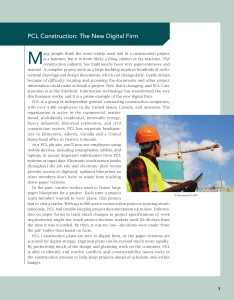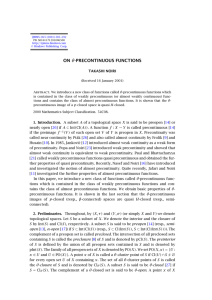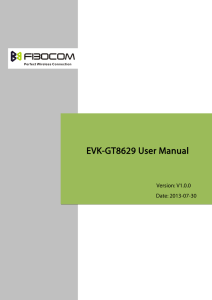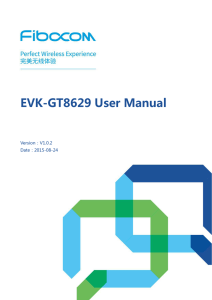Financial Management Introduction
advertisement
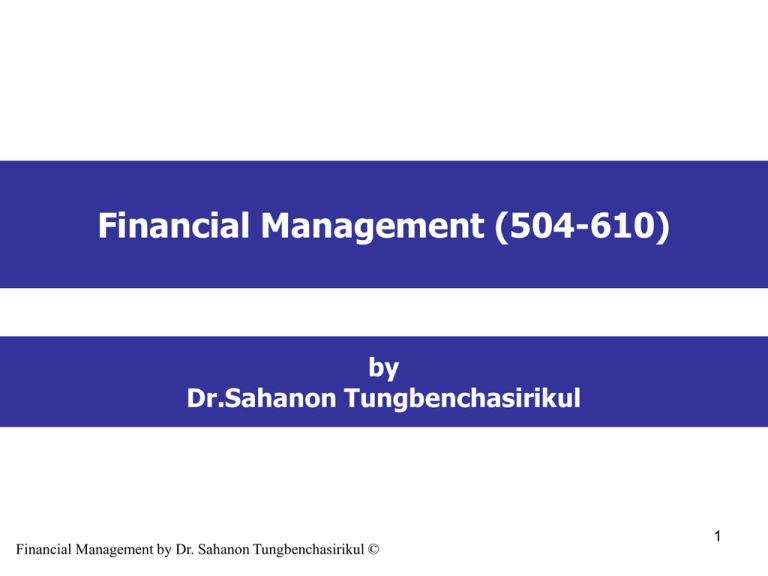
Financial Management (504-610) by Dr.Sahanon Tungbenchasirikul Financial Management by Dr. Sahanon Tungbenchasirikul © 1 Copyrights With regard to Copyright Act B.E. 2537 (1994): • All elements in the presentation (i.e., words, clauses, sentences, pictures, symbols, tables, and trademarks) are obtained from textbooks, academic journals, websites, and other sources of knowledge. These have been claimed to have copyrights. • The presentation is solely used for academic, not for any commercial, purposes. Financial Management by Dr. Sahanon Tungbenchasirikul © 2 My Short Biography Work Experience • • • • DGM (Strategic Planning Manager), Thai Smartcard Co. Ltd., a subsidiary of CPALL Group, 2011 - Present AVP (Client Strategy Manager) SCB Plc., 2008 - 2011 AVP (Corporate Planning) TMB Bank Plc., 2006 - 2008 Analyst, Management Solutions International Ltd., a subsidiary of TEAM Group of Companies, 2005 - 2006 Education Background • • • • PhD (Business Administration), University of Manchester, UK, 2005 M.A. (Economics), University of Manchester, UK, 2000 M.A. (Business Economics), Chulalongkorn University, 1999 B.Sc. (Economics), Kasetsart University, 1998 E-mail: s_tungbenchasirikul@hotmail.co.uk ; Tel: 086-668-7786 Financial Management by Dr. Sahanon Tungbenchasirikul © 3 General Discussion Topics • • • • • Course Objectives Study Overview (see details in the course syllabus) Lecturer-Student Agreement Mark Allocation and Grading Policy Brief: Group Assignments Financial Management by Dr. Sahanon Tungbenchasirikul © 4 Course Objectives • To provide financial management understandings in both theoretical and practical aspects. • To demonstrate how to apply financial management concept to explain real business situations and solve problems. • To enable students to enhance their analytical skills, judgments, and constructive comments by reading actual business and financial reports, and in turn undertaking group assignments. Financial Management by Dr. Sahanon Tungbenchasirikul © 5 Lecturer-Student Agreement • Keen to share ideas and participation. • Respect lecturer and other classmates; we do not tolerate offensive behavior. • If you don’t understand, feel free to ask me; don’t be quite. • No silly question, every question is counted. • Read guidelines carefully, when you undertake group assignment, and write a report. • While you concentrate on getting MBA, you must learn social skills, this is the best moment to do so. • 3Cs for Group Report = Cooperation, Creativity, and Contribution. Financial Management by Dr. Sahanon Tungbenchasirikul © 6 Mark Allocation and Grading Policy • • • • • Group Presentations (2 Sessions) Class Participation Take-Home Exercises (2 Times) Final Exam Total Final Examination • Answer as many questions as you can • Closed book examination! • Allow to take two A4-paper shortnotes with you in the examination. • Cheating means you fail the course (F). Financial Management by Dr. Sahanon Tungbenchasirikul © 40 Marks 15 Marks 10 Marks 35 Marks 100 Marks • • • • • • • Grade Grade Grade Grade Grade Grade Grade A 85 or Above A- 80 – 84 B+ 75 – 79 B 70 – 74 B- 65 – 69 C+ 60 – 64 C 55 – 59 7 Part 1 - Basic Practices • Financial Environment • CFO Roles • Financial Statement Analysis • Financial Planning Financial Management by Dr. Sahanon Tungbenchasirikul © 8 Part 2 - Financing • Capital Structure Decision • Debt Financing • Equity Financing • Dividend Decision • Working Capital Management Financial Management by Dr. Sahanon Tungbenchasirikul © 9 Part 3 - Valuation • Risk and Return • Time Value of Money • Cost of Capital or Required Rate of Return • Asset Price Valuation Financial Management by Dr. Sahanon Tungbenchasirikul © 10 Part 4 - Investment • Analysis of Project Feasibility • Capital Budgeting: Cash Flow Evaluation • Cash Flow Estimation • Project Risk Evaluation Financial Management by Dr. Sahanon Tungbenchasirikul © 11 Group Presentation Financial Management by Dr. Sahanon Tungbenchasirikul © 12 Brief: Group Presentation IMF has claimed that world economy already passed the global economic crisis and, will gradually recover from 2010 onwards. Evidence has displayed that various economic regions (e.g. USA, Asia-Pacific, ASEAN) overcome financial crisis and eye on economic growth. However, governments across the world still keep expansionary monetary policy and deficit fiscal policy not only to stimulate consumption and investment, but also to avoid repeated economic recession. Likewise, various nations (e.g. Malaysia, Singapore) boost their financial sector strengths and competitive advantages of business sectors. It is evident that a number of listed companies in Stock Exchange of Thailand experienced Sub-prime crisis, but they still enjoy good financial performances. This indicates the company’s long-term competitive advantages. Financial Management by Dr. Sahanon Tungbenchasirikul © 13 Brief: Group Assignment (Cont.) Students are required to select one of the following listed companies (Page 15), and in turn conduct the analysis and presentation. It is recommended that students should read the company’ annual report or Disclosure Form 56-1 for at least 3 years (2010-2012) to understand its overall management and business scope as well as other key information, which are useful for completing group assignment. Generally, students can download annual reports from the company websites or access via Stock Exchange of Thailand website (www.settrade.com). Financial Management by Dr. Sahanon Tungbenchasirikul © 14 Brief: Group Presentation (Cont.) Requires each group to choose one of the following listed companies: • • • • • • • • • • • • ADVANC (Advance Info Services Pcl.) BANPU (BANPU Pcl.) BH (Bumrungrad International Pcl.) BIGC (Big C Super Center Pcl.) CPALL (CPALL Pcl.) EGCO (Electricity Generating Pcl.) LH (Land & House Pcl.) MAKRO (Siam Makro Pcl.) MINT (Minor International Group Pcl.) PS (Pruksa Real Estate Pcl.) PTT (PTT Pcl.) SCC (The Siam Cement Pcl.) Financial Management by Dr. Sahanon Tungbenchasirikul © 15 Group Presentation - #1 • • • • Summarize the company’s business scope: your team need to displays its product lines and existing customer markets. Identify and provide the evidence of external business factors (e.g. crude oil price, political situation), which negatively/positively affect the company’s business operations and performances. Conduct financial statement analysis distinguished into four groups of financial ratio (i.e. liquidity, efficiency, profitability, and financial leverage ratio) during 2010-2012 period. In turn, your team is required to give the outlook of financial performance. Explain how financial market and financial institutions can support the firm’s financial needs, and in turn, business operations. 15 Marks Presentation Date: Week 8 Financial Management by Dr. Sahanon Tungbenchasirikul © 16 Group Presentation - #2 • • With regard to Annual Report or Disclosure Form 56-1, your team needs to concisely summarize: (1) the Company’s Corporate Plan from 2010-2012 and create (2) the Company’s Future Corporate Plan in 2013-2014. Your team has to conduct Financial Statement Projection for two years (2013 2014) with the following assumptions: – 2013-2014 investment projects are financially sound (NPV > 0 and good IRR). – The Company Revenue increases 10% for two years (2013 - 2014) and other items in Profit and Loss Statement increase in the same proportion (Common-Sized Increase), – In Balance Sheet, inventory and account receivable increase 10%, account payable increase 10%. – Your team should add some assumptions to make the balance of three Projected Financial Statements (Profit & Loss Statement, Balance Sheet, and Cash Flow Statement). • With regard to the Company’s Future Corporate Plan in 2013 - 2014, your team must illustrate: (1) capital structure (Leverage, Debt:Equity) and (2) debt and capital financing instruments and plans. 25 Marks Presentation Date: Week 12 Financial Management by Dr. Sahanon Tungbenchasirikul © 17 Group Presentation - #2 • Explain whether or not the Company can gain the efficiency of working capital management during 2010-2012 (short-term financial needs and cash conversion cycle). If your team is assumed to be the Company’s CFO, what you intend to do to improve working capital management in 2013-2014. 25 Marks Presentation Date: Week 12 Financial Management by Dr. Sahanon Tungbenchasirikul © 18 Take-Home Assignments Financial Management by Dr. Sahanon Tungbenchasirikul © 19 Take-home Assignment 1 (Total 5 Marks) Answer questions 1 - 4 1. Capital Structure Discuss: Do you agree with the claim that firms in different industries have different capital structures? (Hint: you should employ capital structure flowcharts and diagrams to compare capital structures of firms from different industries). 2. Current Asset Management Situation: Andrews Winters is interested in studying the frameworks of current asset management of three different industries, namely, retail modern trade, construction, and car manufacturing. Can you display diagrams, which reflect such frameworks, and provide the concise summaries. Submission Date: Week 6 Financial Management by Dr. Sahanon Tungbenchasirikul © 20 Take-home Assignment 1 (Continue) 3. Operating Leverage Discuss: Robert Donovan and his associates are interested in acquiring a company either a large modern trade store with low operating leverage or a car engine producer with high operating leverage. They appoint you to be their financial advisor to explain the impacts of operating leverage on profitability of both modern trade store and car engine producer (Hint: you should explain with regard to different business scenarios). 4. Cash Conversion Cycle Discuss: Nicolas Taylor, the Chairman of the Zoo and Amusement Park Company, has appointed Kimberly Summers to be chief financial officer (CFO) since January 2013. He requires Kimberly to explain cash conversion cycle to junior financial officers in the Company (Hint: you can use flowchart to support your explanation). Submission Date: Week 6 Financial Management by Dr. Sahanon Tungbenchasirikul © 21 Take-home Assignment #2 (Total 5 marks) Answer question 1 - 4 1. Common Stock Valuation Situation: Richard Tailor is interested in finding the value of a corporate common stock that he recently purchased. The newly issued common share displays 1,000 / share (P = 1,000) and pays dividend 150 annually for 30 years. Another common share of similar risk has a 12% required annual rate of return or discounted rate. What is common stock value (VS)? 2. Corporate Valuation Situation: Serena Lewis, the owner of a second-hand car company, is interested in evaluating the value of her company operations. She projects the free cash flow for the future 5 years as follows: 1,115, 1,250, 1330, 1,345, & 1,360 (i.e. FCF1 - FCF 5). She calculates weight average cost of capital (WACC) of her company for 8%. What is her corporate value (VOP)? Submission Date: Week 11 Financial Management by Dr. Sahanon Tungbenchasirikul © 22 Take-home Assignment #2 (Continue) 3. Weight Average Cost of Capital (WACC) Situation: Brian Bishop invests in 12 fast food restaurants in Bangkok. He has a target capital structure that the ratio of debt, preferred stock, and common stock is 30%, 30%, and 40% respectively. The bankers expect Brain to pay interest for 6.5% per year and tax rate equals 30% of profit. Preferred stockholders expect Brian to provide dividend of 8.5% per year. Common shareholders request Brain to pay dividend of 7.5% per year. What is WACC? 4. Principles of Project Feasibility Discuss: Eddy Kohler is an investor, who is interested in bidding for a new copper mining project in Mexico. He wants to win a 15 year gold mining concession from South African government, and in turn, hires a financial consultant team (you are also in this team) to conduct project feasibility study. He asks you to summarize key principles of project feasibility with concise details. Submission Date: Week 11 Financial Management by Dr. Sahanon Tungbenchasirikul © 23







